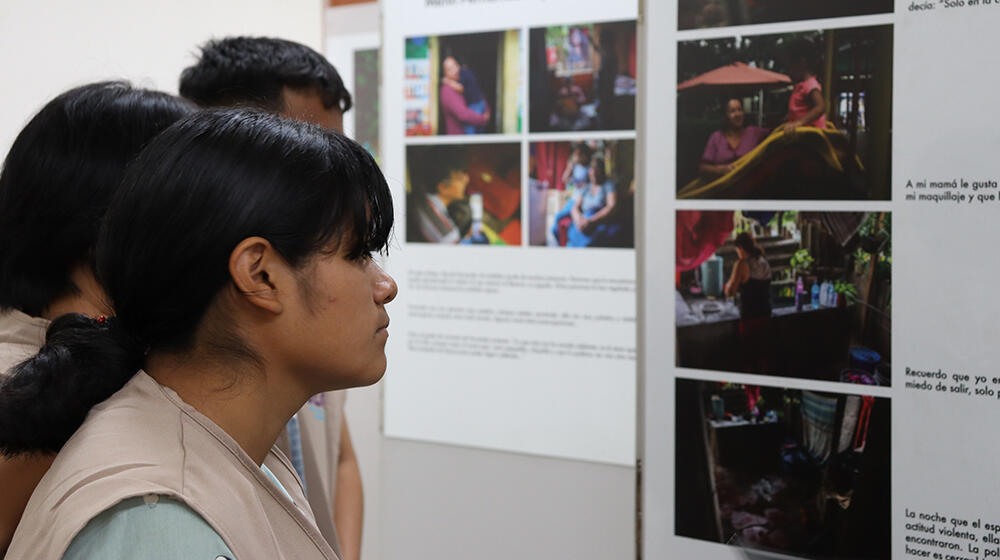El Salvador is the smallest and most densely populated country in Central America. The country's security situation has rapidly deteriorated over the last several years. The country continues to suffer from extreme levels of gang-related violence and has one of the highest homicide rates in the world. Additionally, El Salvador is extremely vulnerable to climate shocks, with 95% of the population living in high-risk areas. Recurrent droughts and floods have increased the risk of food insecurity. El Salvador, together with Guatemala and Honduras, make up the so-called "northern triangle", a region where widespread violence and insecurity, poverty and climate shocks have produced high levels of forced migration. Conditions along irregular migration routes are precarious, with almost no possibilities for meeting basic needs, including personal hygiene. Women and girls also face increased risks of sexual violence and exploitation. UNFPA supports health centers serving migrant women in the western part of the El Salvador, along the border with Guatemala (San Cristóbal, La Hachadura and Las Chinamas). The objective is to improve availability and access to contraceptives (including emergency oral contraception), antiretroviral drugs for people living with HIV/AIDS, and antibiotics for women and young people. In addition to providing supplies, UNFPA also trains local health personnel on various aspects of sexual and reproductive health and gender-based violence.
- Home
- Data
- Humanitarian Emergencies
- El Salvador Humanitarian Emergency
Data Menu
-
Country Pages
-
Asia & the Pacific
- Afghanistan
- Bangladesh
- Bhutan
- Cambodia
- China
- India
- Indonesia
- Iran, Islamic Republic of
- Lao People's Democratic Republic
- Malaysia
- Maldives
- Mongolia
- Myanmar
- Nepal
- Pakistan
- Papua New Guinea
- Philippines
- Sri Lanka
- Thailand
- Timor-Leste
- Viet Nam
-
Eastern Europe & Central Asia
- Albania
- Armenia
- Azerbaijan
- Belarus
- Bosnia and Herzegovina
- Georgia
- Kazakhstan
- Kosovo Office
- Kyrgyzstan
- Moldova, Republic of
- North Macedonia
- Serbia
- Tajikistan
- Türkiye
- Turkmenistan
- Ukraine
- Uzbekistan
-
Arab States
- Algeria
- Djibouti
- Egypt
- Iraq
- Jordan
- Lebanon
- Libya
- Morocco
- Oman
- Palestine
- Somalia
- Sudan
- Syrian Arab Republic
- Tunisia
- Yemen
-
East & Southern Africa
- Angola
- Botswana
- Burundi
- Comoros
- Congo, the Democratic Republic of the
- Eritrea
- Eswatini
- Ethiopia
- Kenya
- Lesotho
- Madagascar
- Malawi
- Mauritius
- Mozambique
- Namibia
- Rwanda
- Seychelles
- South Africa
- South Sudan
- Tanzania, United Republic of
- Uganda
- Zambia
- Zimbabwe
-
Latin America & the Caribbean
- Argentina
- Bolivia, Plurinational State of
- Brazil
- Chile
- Colombia
- Costa Rica
- Cuba
- Dominican Republic
- Ecuador
- El Salvador
- Guatemala
- Haiti
- Honduras
- Mexico
- Nicaragua
- Panama
- Paraguay
- Peru
- Uruguay
- Venezuela, Bolivarian Republic of
- Caribbean (multi-country)
-
West & Central Africa
- Benin
- Burkina Faso
- Cabo Verde
- Cameroon
- Central African Republic
- Chad
- Congo
- Côte d'Ivoire
- Equatorial Guinea
- Gabon
- Gambia
- Ghana
- Guinea
- Guinea-Bissau
- Liberia
- Mali
- Mauritania
- Niger
- Nigeria
- Sao Tome and Principe
- Senegal
- Sierra Leone
- Togo
-
Country Menu
Humanitarian needs
Last updated on - June 2024
Humanitarian funding
Resources in US$
Key humanitarian results 2023

People reached with awareness-raising activities and GBV-lifesaving information in-person

Dignity kits and/or other Non-Food Items distributed

Non-specialised GBV humanitarian workers / frontline workers who were trained /oriented on GBV core concepts and guidelines
Disclaimer
- Results data are reported and updated as they become available.
- -Targets and UNFPA's populations of concern, including women of reproductive age and pregnant women, are estimated using the MISP calculator.
- -Funding estimates are based on country planning processes, including inter-agency humanitarian response plans and regional refugee and resilience plans.
Related content



